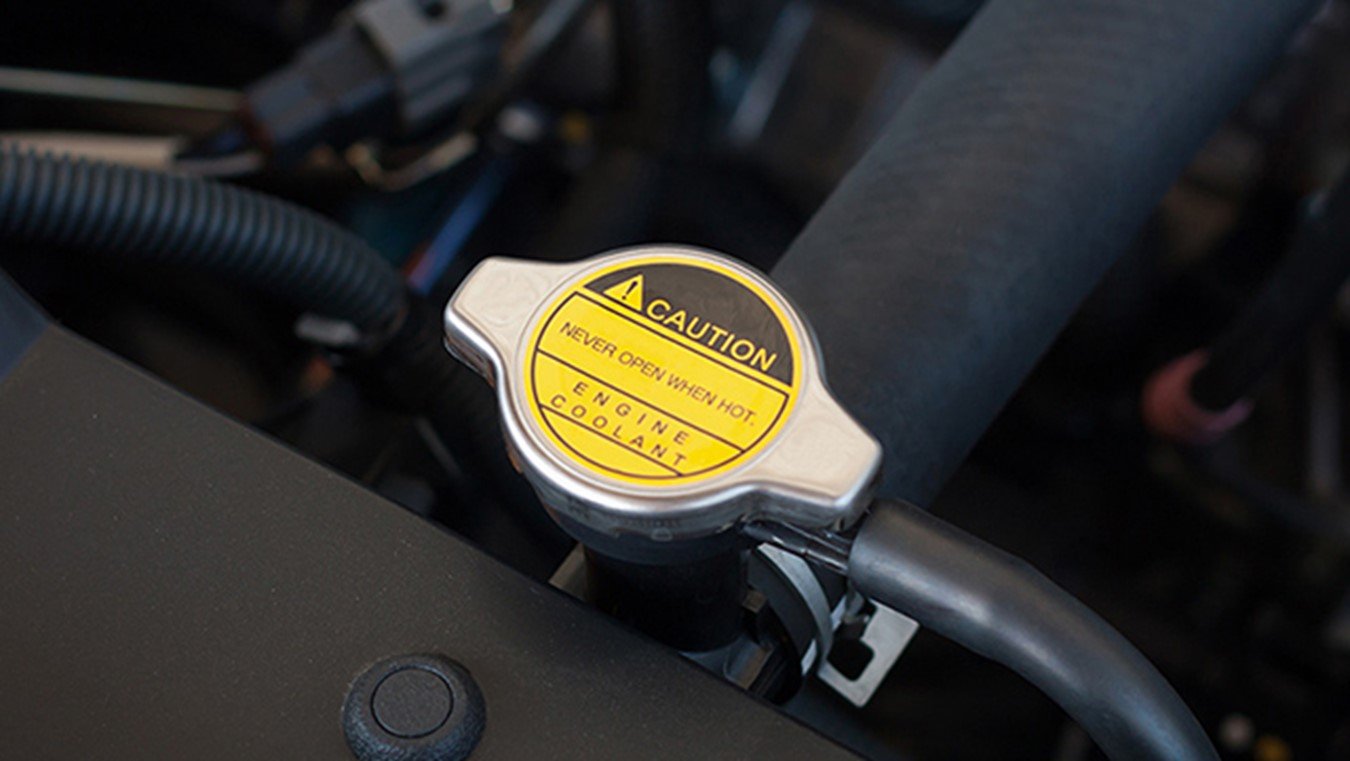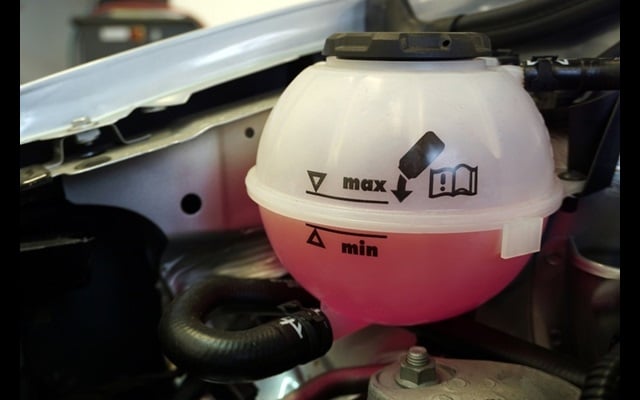Attempting to refill the engine coolant yourself? Make sure the engine has completely cooled before opening the coolant filler cap.
Engine coolant is a mixture of water and anti-freeze that helps to stop your engine overheating.
Most modern cars have a sealed cooling system so they shouldn’t need topping up. Unless, of course, they’ve sprung a leak.
Check your engine coolant every couple of weeks so you can spot any problems early. It could save you a lot of money and hassle.
On this page, we’ll explain how you can check your engine coolant, how to know what type of coolant your car needs, why cars sometimes overheat and what you should do about it, as well as what the low coolant warning light looks like.
What is engine coolant?
Coolant is a liquid that's added to a car's engine cooling system. It's usually a dilution of antifreeze and water.
It stops the water in the system from freezing under normal cold weather conditions and it also raises its boiling point.
Along with a pressurised system, this helps to reduce the risk of overheating.
Can I refill coolant myself?

Yes, you can refill your engine coolant yourself. Simply locate your car’s coolant cap and top up with a 50/50 mix of water and coolant. You can check your car owner’s manual to make sure you have the right type of engine coolant.
You only want to fill the coolant so that it’s between the min and max lines, which you should be able to see.
Attempting to refill the engine coolant yourself? Make sure the engine has completely cooled before opening the coolant filler cap.
How to check your coolant
Many modern cars will have a dashboard warning light with an engine coolant symbol to let you know if there's a problem with your coolant. You should get your car checked at a garage if the warning light comes on.
If you need to check it or top it up manually, here's what to do.
1. Make sure that the engine is cool
- Before you start, you need to ensure the engine is cool before opening the coolant cap. To be safe, wait at least 30 minutes after your engine has been switched off (if your engine has overheated, you'll need to wait even longer).
2. Find the expansion tank
- Make sure you find the right tank (adding antifreeze to the screen wash, brake fluid or power steering reservoir could cause damage).
- Check your vehicle handbook to find the location of the coolant filler cap.
3. Check the engine coolant level
- The coolant should be between the min and max marks on the side of the expansion tank.
- If the coolant level is low this can also cause problems with your car heater. A symptom of this could be cool air coming from the dashboard vents even when the dial is set to ‘hot’.
4. Check hoses for problems
- Check any hoses that you can see at the same time.
- Look out for engine coolant leaks.
- Wet or white staining is a sign of possible problems to come.
5. Top up if necessary
Important: Only do this when the engine is cold.
- If the coolant needs topping up, don't remove the filler cap unless the engine is cold – you could be scalded by a sudden release of pressurised hot water.
- Make sure you use the right antifreeze – different types don't mix well.
- Antifreeze doesn't just protect your engine in winter. It helps stop corrosion and scale build-up all year round.
6. Take it to a garage
- It's not normal for the coolant level to drop.
- If you see that it's dropped, get your car checked over at a garage.
We provide 24/7 roadside assistance.
How do you know if your engine coolant level is low?

First, locate your car’s coolant tank, it’s usually marked with a cap that either says ‘engine coolant’, ‘never open when hot’ or a symbol with an exclamation mark. It could also be marked with a combination of all the above.
You’ll then want to look at the tank itself to check whether the coolant level is low. If it’s low, it’ll be below the ‘min’ line. You need to top up the coolant so that it’s between the ‘min’ and ‘max’ lines.
Can I drive my car if it says 'check coolant'?
If your car is showing an amber or red engine coolant symbol (usually an image of a thermometer or a liquid tank) then it’s best to either check your coolant and top it up if it needs it, or get your car checked over by a mechanic.
The amber light means your coolant level is low, while the red light means your car is overheating or that the coolant is below the minimum level that it should be. In either case, we recommend that you top up before continuing to drive, otherwise it could seriously damage your car.
Can you put water in engine coolant?
Important: Only top up when the engine is cold.
It's not advised to add water to your engine coolant, unless the coolant level is lower than it should be and it's an emergency.
Topping up your car coolant with a bit of water is okay to help you get your car to the nearest garage.
If the dilution level is left too weak over the winter, the water in the cooling system could freeze and cause engine damage.
Can you use water instead of coolant in the summer?
You should only top up your engine coolant levels with water if your car is displaying a low coolant level warning light and you need to drive your car to the nearest garage. Doing this in the summer is risky as your car will naturally heat up quicker. In this case, it may be better to call out a mechanic to come and check your car, or you can top up with the right coolant if you’re carrying it with you.
What coolant does my car need?
There are different types of engine coolants on the market, also called antifreeze. It's important to buy the right one for your vehicle.
If you're wondering "which engine coolant is right for my car?", then our antifreeze advice page is a good place to start.
Is coolant the same as antifreeze?
Coolant is the name given to the liquid that's pumped around the engine to keep it cool. This is usually a mixture of water and antifreeze. Some manufacturers specify a pre-mixed coolant, to which neither antifreeze or water should be added. Others advise of a mix of water and antifreeze, at a specified concentration.
What is a cooling fan?
When your car's moving, air flows through the radiator to keep your engine's temperature 'normal'.
But if you stop – in a summer traffic jam, for example – your engine relies on its cooling fan to force air through the radiator. The fan's controlled by the coolant temperature sensor and your car's engine management system.
How to check your cooling fan
Cooling fans in car engines should start up automatically. If they don't there may be a fault with the coolant temperature sensor, the wiring or the fan itself.
Ask your local garage to give it the once over if you think there's a problem or your car is overheating.
Here's a step-by-step guide showing how to check your cooling fan.

How do cars overheat?
If you never check your car's coolant fluid level or pay attention to the engine coolant temperature gauge, you could face a hefty repair bill if your engine overheats.
At best it could be a couple of hundred quid to repair the cooling fan, more than that to replace the head gasket, or at worst, it could be over a four-figure sum for a new engine.
Why do engines overheat in the summer?
Overheating is a much bigger problem during the summer than in the winter:
- Engines operate at higher temperatures in summer.
- There isn't the cold winter air to take away a lot of the heat.
- The cooling system is tested more when you take it on a long trip or get stuck in a summer traffic jam.
Many cars are only used on local journeys. On short trips, the engine barely reaches normal operating temperature, so the cooling system isn't tested.
However, that changes when the car's suddenly loaded with luggage and passengers for a long summer trip in hot weather, which is when problems in the system can show up.
With all this being said, it's still possible for a car to overheat outside of the summer months, so always make sure your car coolant is topped up.
Find out how breakdown cover can help you if you have car trouble:
How to avoid your engine overheating
Here's what you can do to keep your engine cool:
- Check your engine coolant level using our simple steps.
- Check your cooling fan – a seized cooling fan is the most common cause of initial overheating. Make sure the engine is cold and switched off. Electric cooling fans can switch themselves on even when the keys are removed. If you're not sure what to do, call us. Or you can get your garage to carry out a full cooling system test.
- If the temperature gauge rises, the best way to temporarily deal with it is to turn the heater up full and the air conditioning on.
Try to get into the habit of regularly checking your car, including the engine coolant level and fan.
Modern cooling systems shouldn't really need topping-up between services. So if you notice that the car's coolant has dropped or that there's an engine coolant leak, get it checked out. For 24/7 Roadside Assistance, you can get breakdown cover from our Patrols.
My engine is overheating but the coolant is full
It's possible for your engine to overheat while your coolant level is full. Possible causes include a faulty thermostat, water pump, cooling fan or coolant blockage.
Published: 14 April 2016 | Updated: 13 October 2023 | Author: The AA
